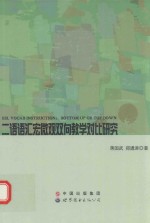

二语词汇宏微观双向教学对比研究PDF电子书下载
- 电子书积分:9 积分如何计算积分?
- 作 者:蒋国武,郑通涛著
- 出 版 社:北京/西安:世界图书出版公司
- 出版年份:2016
- ISBN:9787519209346
- 页数:180 页
Introduction 1
Chapter 1:Background 2
1.1 Introduction 2
1.2 Statement of the Problem 4
1.3 Research Objectives 4
1.4 Significance of the Study 5
1.5 Vocabulary Teaching in China 5
1.5.1 English as a Second Language in China 5
1.5.2 The Role of Vocabulary Knowledge 6
1.5.3 The Current Situation of Vocabulary Teaching in China 7
Chapter 2:Literature Review 8
2.1 Introduction 8
2.2 Approaches and Methods in Language Teaching 9
2.3 Approaches to Vocabulary Teaching 11
2.3.1 Incidental Approach 12
2.3.2 Intentional Approach 13
2.3.3 Word Association Approach and the Contextualised Approach 16
2.4 Vocabulary Knowledge and Development 17
2.4.1 Vocabulary Size 17
2.4.2 What is Involved in Knowing a Word? 19
2.4.3 Receptive Knowledge versus Productive Knowledge 21
2.4.4 The Development of Vocabulary Knowledge 23
2.4.5 Vocabulary Teaching and Learning Burden 29
2.5 Language Processing and the Conceptualisation of Bottom-up and Top-down 31
2.6 The Components of a Vocabulary Course 36
2.6.1 The Goals of Vocabulary Teaching 37
2.6.2 Needs Analysis of a Vocabulary Course 38
2.6.3 Environment Analysis 42
2.6.4 Teaching Principles 42
2.6.5 Teaching Content and Sequence 43
2.6.6 Format and Presentation 44
2.6.7 Monitoring and Assessment 46
2.6.8 Course Evaluation 47
2.7 Previous Research 48
2.7.1 Research on Bottom-up and Top-down Approaches 48
2.7.2 Research on Vocabulary Teaching 51
2.8 Chinese Culture and the Role of Culture in EFL Teaching 55
2.8.1 The Fundamental Features of Chinese Culture 56
2.8.2 The Role of Culture in EFL Teaching 57
2.9 Summary and Implications 59
Chapter 3:Methodology and Design 61
3.1 Introduction 61
3.2 Overview of the Research Project 61
3.3 Research Design 62
3.4 Participants 62
3.4.1 Research Sample 62
3.4.2 Recruitment 63
3.4.3 Allocation of Participants 64
3.5 Instruments 66
3.5.1 Background Information Questionnaire 67
3.5.2 Vocabulary Knowledge Tests 68
3.5.3 Course Evaluation Questionnaire 70
3.6 Research Procedure 71
3.7 Instruction 72
3.7.1 Teaching Procedure 73
3.7.2 Teaching Materials and Resources 75
3.7.3 Teaching Activities 77
3.8 Data Analysis 78
3.9 Summary 80
Chapter 4:Data Analysis 81
4.1 Overview 81
4.2 Preliminary(Descriptive)Analysis 81
4.3 Main Analysis 83
4.3.1 The Results of Academic Vocabulary Size Tests(AVST) 84
4.3.2 The Results of Controlled Productive Knowledge Tests(CPKT) 85
4.4 Conclusion 86
Chapter 5:Discussion 87
5.1 Overview 87
5.2 The Different Effect between Bottom-up and Top-down Approaches 88
5.2.1 Nature of L2 Lexical Acquisition and its Alignment with Bottom-up Processing 89
5.2.2 Learner's Low Proficiency Level Favours Bottom-up Processing 90
5.2.3 Socio-cultural and Traditional Factors in the Chinese Context 91
5.3 About the Vocabulary Course 102
5.3.1 Composition of the Course(in terms of Nation's four strands) 102
5.3.2 The Role of Explicit/Direct Vocabulary Instruction 104
5.3.3 Input Processing Management 105
5.3.4 The Instruction Targeted both Receptive and Productive Skills 107
5.3.5 Combination of both the Key Words Approach and the Contextualised Approach 109
5.3.6 Use of Online Resources 110
5.4 Conclusion 111
Chapter 6:Conclusion 112
6.1 Project Summary 112
6.2 Contribution of the Study 114
6.2.1 Contributions to Scholarship in the Field of L2 Research 114
6.2.2 Contributions to Second Language Pedagogy 114
6.3 Limitations of the Current Study and Recommendation for Future Research 115
6.4 Recommendations for Second Language Pedagogy 116
6.4.1 A Plausible,Heuristic and Eclectic Approach in ELT 117
6.4.2 Eclectic Dynamic Language Acquisition Model Integrating Bottom-up and Top-down Dimensions 120
6.5 Final Comments 124
References 126
Appendix A:Teaching Syllabus 137
Appendix B:Lesson Plan 140
Appendix C:Teaching Materials 148
1.Academic Words Lists(AWL)(Coxhead,2000) 148
2.Sub-lists of the AWL(Coxhead,2000) 153
3.IELTS Preparing Book(IELTS 7,2008,p.78) 154
4.The List of Target Teaching Words 156
5.Academic Vocabulary Exercises 160
Appendix D:Teaching Resources 166
1.Word Formation:http://wordinfo.info/ 166
2.Bilinguial online dictionary:http://www.iciba.com/ 166
3.WordNet Search 3.0:http://wordnetweb.princeton.edu/perl/webwn 167
4.Visualthesaurus:http://www.visualthesaurus.com/trialover/ 168
5.Oxford Collocation Dictionary Online:http://www.ozdic.con 168
6.Long Dictionary of Contemporary English:http://www.ldoceonline.com 169
Appendix E:Research Instruments 170
1.Background Information Collection Form 170
2.Vocabulary Pre and Post Tests 175
3.Course Evaluation Questionnaire 179
- 《培智学校义务教育实验教科书教师教学用书 生活适应 二年级 上》人民教育出版社,课程教材研究所,特殊教育课程教材研究中心编著 2019
- 《指向核心素养 北京十一学校名师教学设计 英语 七年级 上 配人教版》周志英总主编 2019
- 《新课标背景下英语教学理论与教学活动研究》应丽君 2018
- 《大学英语教学的跨文化交际视角研究与创新发展》许丽云,刘枫,尚利明著 2020
- 《中国少数民族唢呐教学曲选》胡美玲编 2019
- 《语文阅读与写作教学研究》李玉红,陈晓玲,王芬著 2018
- 《语文教育教学实践探索》陈德收 2018
- 《中学语文教学案例研究》贺卫东主编 2019
- 《职业英语教学研究 2017-2018》刘晓晶 2018
- 《观察、阅读、写作小学作文整体教学与思维训练》马芯兰主编 2016
- 《TED说话的力量 世界优秀演讲者的口才秘诀》(坦桑)阿卡什·P.卡里亚著 2019
- 《小手画出大世界 恐龙世界》登亚编绘 2008
- 《近代世界史文献丛编 19》王强主编 2017
- 《课堂上听不到的历史传奇 世界政治军事名人 初中版》顾跃忠等编著 2015
- 《指向核心素养 北京十一学校名师教学设计 英语 七年级 上 配人教版》周志英总主编 2019
- 《365奇趣英语乐园 世界民间故事》爱思得图书国际企业 2018
- 《近代世界史文献丛编 36》王强主编 2017
- 《北京生态环境保护》《北京环境保护丛书》编委会编著 2018
- 《近代世界史文献丛编 11》王强主编 2017
- 《近代世界史文献丛编 18》王强主编 2017
